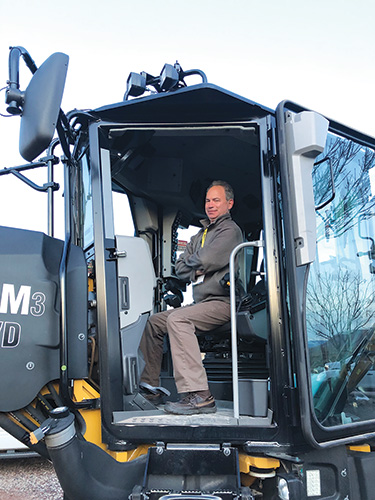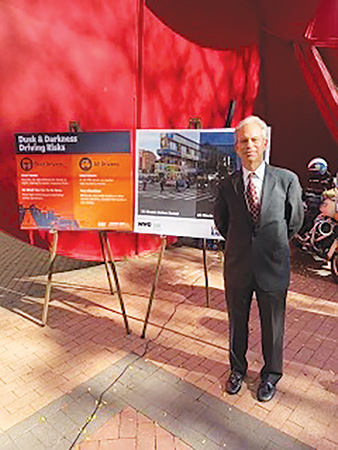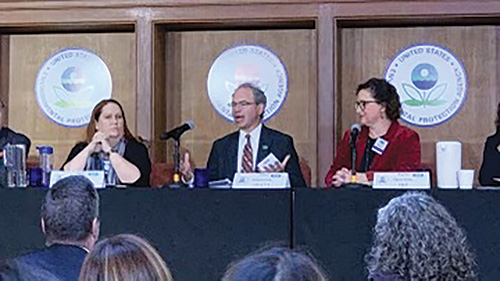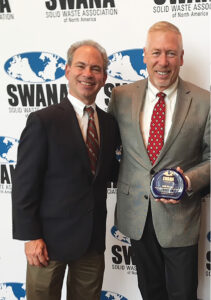As a 25-year industry veteran, David Biderman has been one of the leaders and advocates at the forefront of waste and recycling issues. Recently completing a successful tenure at SWANA, he discusses his goals, accomplishments, industry challenges, and his next steps.

How did you become involved with the waste and recycling industry?
I was an environmental and transportation lawyer in private practice and decided I wanted a different career path. Bruce Parker hired me to join the Environmental Industry Associations (EIA) (now the National Waste & Recycling Association – NWRA) in 1997 as an attorney. Bruce had just been promoted from General Counsel to CEO, and there was an opening at EIA. After a few years, I was promoted to General Counsel and then my role expanded. I was NWRA’s first Safety Director, managed its New York City chapter, and became Vice President for Government Affairs. I was at NWRA for 18 years and obtained an in-depth understanding of the solid waste industry and its issues.
You recently had a successful tenure with SWANA as their Executive Director and CEO for several years. Discuss your role in the organization, the goals you had for the association when you came into the job and some of the most important ones you achieved.
When I joined SWANA in April 2015, its International Board had just approved a new and ambitious Strategic Plan, but had rejected a proposed annual budget. Several chapters were on the verge of dissolution. My initial goals were to address the financial situation, stabilize the chapters, and begin implementation of the Strategic Plan. By developing new revenue streams and reducing expenses, we were able to improve SWANA’s financial performance. Looking back on my eight-year tenure at SWANA, I can say that the association is financially stable, the staff successfully implemented the 2015 Plan, and the organization has started to implement the new Forward Together Strategic Plan approved in 2022.
An important Strategic Plan goal when I joined SWANA was to increase membership. When I joined SWANA, it had about 8,200 members, and had been at that level for several years. By making SWANA more visible to the industry and participating in the important federal policy issues that impact the industry, I expected we would be successful at growing membership. I recall mentioning to staff a goal of getting to 10,000 members and was told that was not realistic. However, SWANA went over 10,000 members in 2019, briefly exceeded 11,000 members in early 2020, and is at about that level today. I believe that SWANA’s membership value proposition is exceptionally strong, particularly for younger solid waste professionals who are in the early portion of their career and qualify as “Young Professionals” (YPs).

When I joined SWANA, we were scheduled to host the International Solid Waste Association (ISWA) World Congress in September 2017 in Baltimore. To help make this a successful event, we developed close relationships with international-facing organizations in Washington DC, such as the World Bank, and the federal agencies that promote U.S. trade (e.g., Commerce Department). Those organizations and agencies helped promote the event and participated as speakers. Over the past few years, with climate change, marine litter, and plastic pollution on the global environmental agenda, I helped position SWANA and its members to provide assistance to developing nations seeking to address their solid waste challenges. These included providing education in Brazil and Belize, and obtaining a State Department grant that was used to provide online landfill training to nearly 100 Colombians and Chileans in late 2020. I served on the Commerce Department’s Environmental Technologies Trade Advisory Committee (ETTAC) from 2017 to 2023 and was Chair of the ETTAC Waste Management and Circular Economy advisory subcommittee from 2021 to 2022. These engagements have increased my interest in helping U.S. companies provide technical assistance and capacity building to developing countries to help them modernize their solid waste systems and infrastructure.
Because SWANA is the only solid waste association that represents individuals in both the public and private sector, I thought it was important to establish it as a subject matter expert on solid waste issues with Congress and relevant federal agencies. This was largely successful, as SWANA is frequently contacted by congressional staff, EPA, OSHA, the State Department, and other agencies concerning a growing array of domestic and international solid waste, recycling, and sustainability issues.
When National Sword was announced in 2017, I felt it was important for SWANA to play a leadership role in helping local governments and the industry respond to this new challenge. Recycling markets were in free fall. EPA wasn’t providing any leadership. A growing number of communities were abandoning curbside recycling. SWANA established a Recycling Task Force that helped guide our activities. We encouraged EPA to develop a federal strategy for responding to National Sword and pushed hard for EPA to develop a National Recycling Strategy and the ambitious goal of recycling 50 percent of our waste by 2030. SWANA also played an important role in persuading Congress to include grant funding for recycling in the 2021 Infrastructure Bill.
How have you worked with government entities over the years to get more exposure for the industry, especially with regards to safety?
One of the most important achievements of the past few years has been the progress that the solid waste industry has made on safety. Just a few years ago, waste collection was the fifth most dangerous occupation in the U.S. Last year, the federal Bureau of Labor Statistics (BLS) reported it had fallen to seventh. Importantly, the most recent BLS fatality rate for waste collection workers is at its lowest point in more than a decade. This is real progress.
However, as I have said before, this is no time to be taking a victory lap. We still have far too many collisions and incidents, and the reputation of the solid waste industry as being a dangerous one to work in likely inhibits our ability to attract and retain drivers and other front-line workers. So SWANA and others need to continue to focus on improving safety in the industry. It’s the first goal of SWANA’s new Strategic Plan, and I’m a little disappointed that I won’t be leading its implementation.
I have provided safety training for front-line workers in Baltimore, Washington D.C., New Jersey, and New York City over the past few years. I really enjoy interacting with drivers and helpers and helping them to become safer employees. I expect to continue providing safety training and helping both local governmental agencies and companies improve their safety performance.

Photos courtesy of David Biderman.
How important is it to network and grow professional relationships in this industry? What you do think are the most effective ways to do this?
The solid waste industry is terrific one in which to make a career. The people in the industry comprise an unusually tight-knit community. I think it is very important to network and develop relationships throughout the industry. There are several ways to do this. First, I encourage solid waste professionals to attend conferences and other events. Don’t be shy. Walk up to other attendees and introduce yourself. Second, LinkedIn and other digital networking tools are a superb way to identify other people in the industry. Third, find a way to develop content for others that will encourage people to want to network with you. That could include blog posts, writing for a trade publication, or using social media to demonstrate expertise about a specific topic.
What are some of the challenges/trends that you foresee for the industry over the next few years and how can they be proactively addressed?
There will be no shortage of major challenges facing the solid waste industry over the next few years. First, although the worst of the labor shortage appears to be behind us, it remains difficult for some companies and agencies to recruit and retain drivers, helpers, and mechanics. The industry needs to continue to increase compensation, recruit in unconventional ways, and provide flexibility to employees.
Second, safety continues to be an ongoing industry challenge, despite recent improvements. Many smaller employers in both the public and private sectors lack safety resources and expertise and have a disproportionate number of fatal incidents involving workers. Too many employees are on the riding step of the truck when it is backing or going forward at 10 mph or above, or are ignoring lockout tagout or other well-known safety rules and standards. Also, the driving public continues to pose a substantial threat to collection workers, both due to distraction and simply bad driving.
Third, a growing threat to the recycling infrastructure in North America and elsewhere is the profileration of lithium-ion batteries, whose improper disposal is causing fires at waste and recycling facilities on nearly a daily basis. Some recycling facilities are having multiple “thermal” events every week! Although many in the industry are calling for more education of consumers, I believe that national rules governing the labeling and disposal of lithium-ion batteries at end of life is the best way to reduce the fire risk.
Fourth, PFAS regulation is a major concern for solid waste disposal facilities. PFAS is contained in a wide array of consumer products, such as carpets, clothing, and cosmetics. When these materials are thrown away, they typically end up at a landfill. The leachate generated at landfills often contains PFAS, which often is sent to a wastewater treatment facility. As EPA issues regulations under its PFAS Action Plan to reduce exposure to PFAS in drinking water, it is forcing landfills to evaluate expensive leachate treatment options. These new costs will likely be passed on to haulers and the communities they serve. Of particular concern is the possibility of Superfund liability, under which a company can be found strictly and retroactively liable for disposal that occurred decades ago.
A fifth area is the growing interest in reducing greenhouse gas (GHG) emissions. Landfills continue to be a big target, as they are the third biggest human-related source of methane. Recent improvements in methane detection technology and the high-profile overflights of landfills in California in 2016 – 2017 are forcing landfills to evaluate and invest in additional methane mitigation systems. This is an important issue internationally as well, as most of the open dumpsites in developing nations do not have landfill gas systems and are simply venting methane into the atmosphere, contributing to Climate Change.
A sixth area to watch is Extended Producer Responsibility (EPR). A number of states have passed EPR laws (California, Colorado, Maine, and Oregon) and several other state legislatures are considering EPR bills in 2023. The increased interest in EPR laws reflects a growing recognition that market-based approaches that encourage producers of goods to be responsible for recycling are not working effectively. It also reflects that traditional regulatory actions or ambitious recycling goals are not successful in achieving sustainability objectives.
The final trend that I want to mention is electric garbage trucks, often known as “EVs.” There is a tremendous amount of interest in EVs for collecting solid waste and recyclables. A growing number of local governments and companies are piloting EVs in different geographies and on different types of routes. There are some substantial implementation challenges before EVs become commonplace in the United States, but as the cost of the trucks decline, I think we’ll see widespread adoption of EVs in municipal fleets over the next decade.
What are your next steps in the industry? How are you continuing to be involved?
I intend to stay in the solid waste industry. It’s a terrific industry with interesting and important issues. Most importantly, are the wonderful people in this great industry. I have been touched by the outpouring of support I have received from people in the industry concerning my departure from SWANA—including both Young Professionals I met for the first time at WASTECON® in San Diego in December 2022, and industry veterans I’ve known for decades. Thank you.
I am going to take a little bit of time to recharge my batteries and evaluate different opportunities. I’ve been in the industry for 25 years. I have been involved at a high level on a variety of issues, and I think my skills in policy/advocacy and safety, as well as my legal background, will be particularly valuable to both companies and local governments. I will be attending Waste Expo and am speaking at other industry events later this year. I look forward to many years ahead in this great and vital industry. | WA
I first met David when he served as the General Council of the industry’s trade association, which, at the time, was called the Environmental Industry Association (now the National Waste and Recycling Association). David and I worked on many projects, and I always found him to be creative, smart, and caring. He was always willing to assist and provide meaningful perspective and ideas for moving forward. That said, the status quo was never enough for David. He always found a way to do more for the benefit of the environment, for people, and for the industry. His passion for people and the job that this industry does was evident in everything he worked on. Clearly the news media viewed David as the “go to” person for expertise on solid waste and recycling issues and he improved the image of our industry over time.
While David has proven that he has many strengths, I would say that his strongest ones are his advocacy and his passion. Like many of us, he loves the waste industry and sees the value in the work that this industry does every day. As an advocate, David is a clear communicator who addresses issues with common sense and urgency. He has a long history of success at the NWRA and at the Solid Waste Association of North America (SWANA).
—Will Flower, Senior Vice President of Corporate and Public Affairs at Winters Brothers and Waste Advantage Magazine Editorial Advisory Board Member, Photo courtesy of Will Flower. David Biderman can be reached at (703) 967-2616 or e-mail [email protected].

